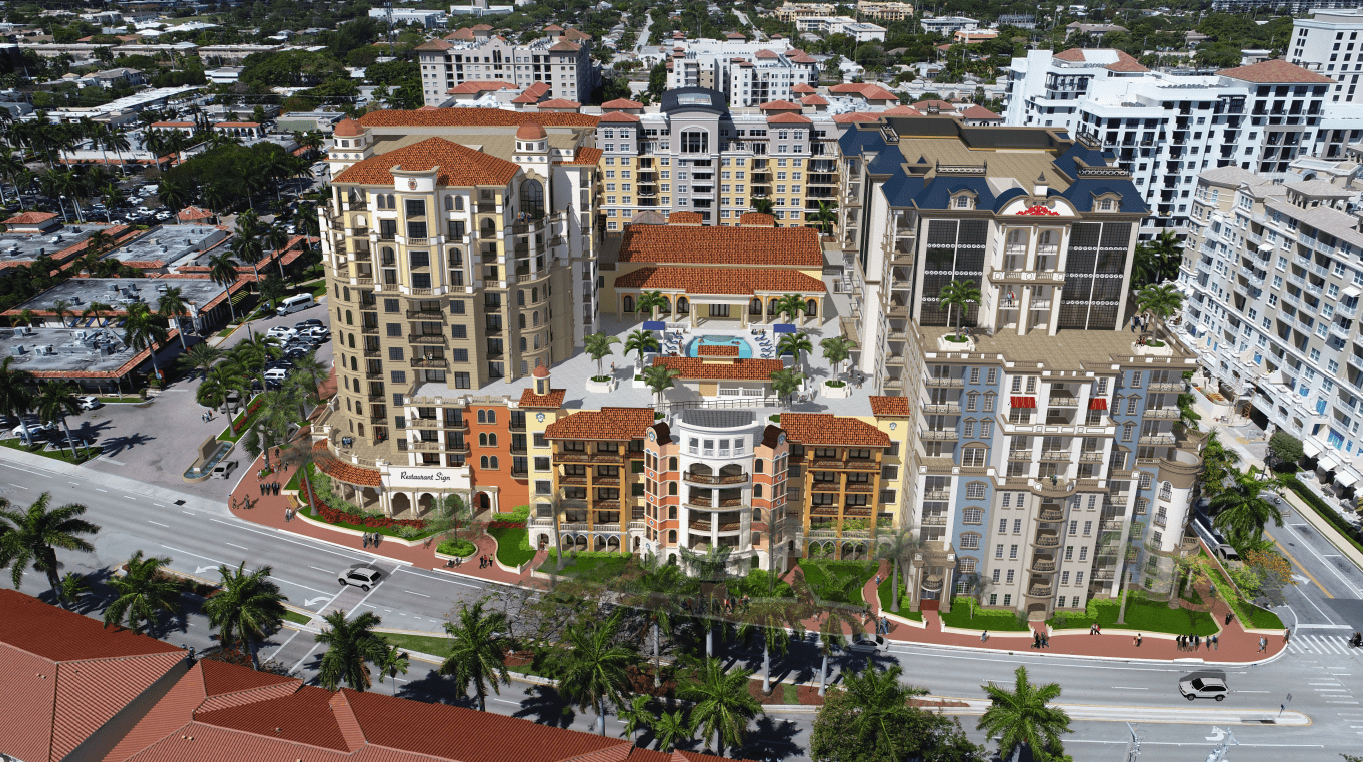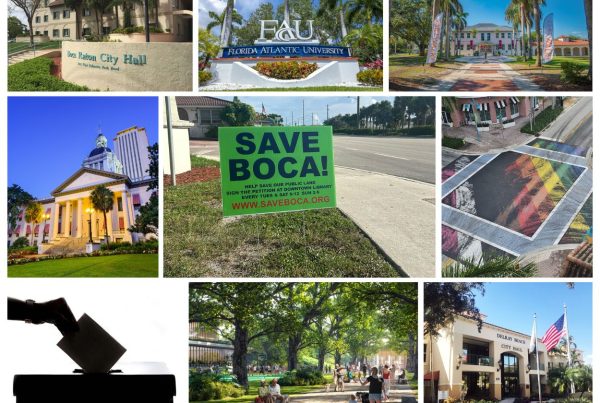Royal Palm Place: big changes ahead
There have been rumors for months about Royal Palm Place’s planned redevelopment. The rumors now are true.
Investments Limited—the property’s owner—has submitted to Boca Raton plans for the second phase of redevelopment. Though the project would include just two buildings, the change would be dramatic.
In Phase 2, Royal Palm Place would demolish roughly 41,000 square feet of retail and replace it with about 16,000 square feet of new retail and 289 residential units. To qualify for the residential, Royal Palm Place proposes to convert what the developer says are 217 hotel rooms that were approved but have not been built.
Phase 1 took place in 2006, with the 10-story and three-story mixed-use buildings on the north side of the complex. That’s when Investment Limited changed the name from Royal Palm Plaza.
At that time, Investments Limited had submitted plans for what company representative Robert Eisen told me Wednesday was “a much more ambitious” second phase than these plans. No kidding. That version included a 250-room hotel, 344 housing units, 85,000 square feet of retail and 121,000 square feet of office. Eisen said those plans envisioned a buildout over 10 years.
Under this new version, Royal Palm Place would redo the section facing Federal Highway and the northeast section facing Mizner Boulevard adjoining Southeast First Street. That’s where the change would be most dramatic. That’s also across the street from the proposed Mizner 200 condo project that was before the city council on Monday —and, seemingly for a time, nearly into Tuesday. More about that in a moment.
Though Phase 2 would add traffic from the new homeowners, Investments Limited calculates that traffic overall would come down because so much retail space— which generates more traffic then residential—would go away. Eisen acknowledged that Royal Palm Place has been “underparked” since it opened in 1966. Investments Limited bought it in 1988. Eisen said this and succeeding redevelopment phases—there could be four more, covering the balance of the complex—gradually would correct the imbalance. After the last phase, Eisen said, Royal Palm Place parking would match city code.
Investments Limited submitted its plans just last month. I will have more as the city reviews the project.
More on Mizner 200
As noted, the larger portion of Royal Palm Place Phase 2 would face Mizner 200. Eisen and other representatives of Investments Limited spoke against the project on Monday. Doug Mummaw, whose architecture firm is designing Phase 2, got 15 minutes more than his allotted five minutes to argue that Mizner 200 does not comply with the city’s downtown building ordinance.
Eisen claims that Investments Limited’s opposition to Mizner 200 is “independent” of its Phase 2 plans. Sure. Anyway, on Monday the council declined to take a final vote on Mizner 200, instead asking the developer’s representatives to work with Investments Limited on what the council called “tweaks” to the condo’s design. The project will come back to the council—acting as the community redevelopment agency—on Aug. 21.
Today, Eisen said, a meeting of all the architects is scheduled. Eisen hopes that the two sides can show up next month with an agreement and thus make for a much shorter meeting. Eisen also has a personal motivation to reach a deal. He has prepaid for a trip to South Carolina to watch the solar eclipse—on Aug. 21.
Swinton Commons
Delray Beach Mayor Cary Glickstein and Planning and Zoning Director Tim Stillings agree that Midtown Delray Beach in its current version is dead.
Last month, after nearly nine hours of debate over two days, the historic preservation board unanimously rejected all requests from Hudson Holdings for the project—formerly known as Swinton Commons—on both sides of Atlantic Avenue at Swinton Avenue. Most notably, the board recommended denial of the site plan. Without that approval, none of the other issues—demolitions, relocations, abandonment of two public alleys—matter.
It was the second smackdown from the historic preservation board. During the first one, Chairman John Miller said that if the city allowed the project, “You might as well pack up the historic preservation board.” The project, Miller said, would “wipe from the map” one of Delray Beach’s few historic neighborhoods. Hudson Holdings revised plans for the $140 million, mixed-use project that would take up seven acres, but the reviews remain negative.
As with all such rejections, Hudson Holdings could appeal to the city commission. The developer did so, but the letter seeking the appeal arrived late in the afternoon of the last day to file it. The letter also did not specify an appeal of the site plan.
Because the letter came so late, Stillings said, the city didn’t have time to ask if there had been an oversight. When the question arose during debate at last week’s commission meeting, City Attorney Max Lohman said, “It’s my job to give advice to applicants.” The commission didn’t just reject Hudson Holdings’ appeals. The commission itself challenged approvals for demolitions, relocations and rebuilding.
Hudson Holding has two options. The developer can make what Glickstein called “substantive modifications” and submit a new plan or wait a year and submit the plan again. Regardless of whether the failure to appeal the site plan was an oversight or intentional, Glickstein said, “It may be a blessing, as it will require the applicant to make some needed (in my view) design changes that should help garner more support.”
Glickstein noted the importance of the project’s location, “anchoring the east end of West Atlantic’s redevelopment, something the commission has already prioritized.” He said, “There is a middle ground, where we can retain much of the look and feel of Swinton’s historical streetscape while getting better design for the larger buildings, where I would prefer to see more office than residential uses.” Glickstein has “communicated” these thoughts to Midtown’s architect, “who has a great appreciation for historic preservation.”
Stillings agrees. After two years of Hudson Holdings trying to make the project work, “We are advising them that is in their best interest to withdraw.”
Andy Thompson still on the scene
Andy Thomson may have lost his Boca Raton City Council race in March to Andrea O’Rourke, but he shows up regularly at city meetings. Most recently, he was at the second waterfront presentation.
People have approached Thomson, he said, about running for the state House in 2018. Republican Bill Hager is term-limited in District 89, which includes Boca Raton. Thomson is a Democrat, but the district is something of a swing seat. Democrat David Silvers got 47.5 percent of the vote in 2014. Hager ran unopposed last year.
But Thomson said he also is considering another run for the city council. Incumbents Jeremy Rodgers and Robert Weinroth are on the ballot next year.
Construction report
With all the building activity—large and small—in Boca Raton, Delray Beach and South Florida, a recent report from Wells Fargo offers some perspective.
Though the construction industry has been building back, construction makes up just 6 percent of all non-farm jobs in Florida. At the height of the real estate bubble, that percentage was 8.8 percent.
So as a portion of the state’s economy, construction remains about one-third lower than where it was before the financial crisis. That number shows just how many houses and condos were being built for flipping, not living.
Train risks very real
I reported Tuesday about the suspected suicide on the Florida East Coast Railway tracks between 20th and 28th streets. It came during testing of All Aboard Florida’s Brightline trains, 32 of which will begin running by fall.
Because there won’t be Brightline stations in Boca Raton and Delray Beach, the focus in those cities has been on the “quiet zone”—safety improvements at grade crossings that will obviate the need for train horns.
Residents like me who live near the FEC tracks like the prospect of horn-free living, but this week’s incident should remind everyone of the risks the trains present. Not only will there be no horns, All Aboard Florida says these trains will be very quiet. The company advises cyclists and pedestrians not to wear earbuds when crossing the tracks. That’s good advice now. It will be better advice soon.








Other than the blue “bates motel” and “haunted house” roofs (Mizneresque not) on the building to the North, a really nice looking project. Question is whether Jim will actually build-it. God knows we need the parking. Great job by Doug Mummaw.
If you can’t beat them, join them. Batmasian was against Mizner Park and now Mizner 200, yet simultaneously rides the coattails with redevelopment. Hopefully, the rest will be redeveloped in due course as it was supposed to fifteen years ago.
As for Swinton Commons, Delray’s stupidity is paramount. What are scattered historical properties frankly in the way to be moved in a coherent ensemble, with new beautiful buildings the board seemed to have hated. Neighborhood character my ass! Where was architectural review for monstrosities like 111 First Delray and The Metropolitan, and SOFA?
How about a map showing the locations being discussed!